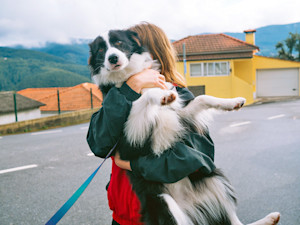4 Ways to Keep Your Dog Busy When They Can’t Exercise
Even if your dog is injured and can't exercise, you can still keep them entertained. Here's how.

Share Article
My extremely active five-year-old dog injured her leg, and I’m supposed to prevent her from exercising for the next six weeks. Frankly, I don’t see how either of us will survive if she can’t run off her extra energy. What can we do?
You and Frankie aren’t alone. Vets frequently advise that you restrict your dog’s activity after a surgery or while they recover from muscle or joint injuries. It’s necessary for their health — but you’re well aware of the downside: An underexercised dog who whines, chews, barks, or develops some equally annoying habit to pass the time. The devil really does find work for idle paws. But don’t fear: There are some things you can do to keep your pup stimulated and relaxed during this time.
Get clear on your dog’s restrictions.
Your first step is to ask your vet to tell you exactly what your dog can and can’t do. Get specific. It’s probably obvious that your two-hour romps through the woods will have to go on pause, but what about a daily 10-minute leash walk? Is she allowed to swim? Are stairs forbidden? It’s possible that there are more options available than you guessed.
Give your dog’s brain a workout.
Okay, so your dog can’t get the physical exercise she’s used to. The key to keeping you both sane lies in exercising her mind. This mental exercise can take many different forms. Training is one of them; time spent doing simple obedience is great for a dog’s brain, and you reap the benefit of a better-trained dog. Ask your pup to sit, lie down, stay, or anything else she knows how to do to earn toys, treats, a belly rub, or a trip outside. Consider a weekly class to clean new skills; it’s a great motivator, and it can provide stimulation for your dog during her exercise quarantine.

Teach your dog new tricks.
In addition to practicing what she already knows, now could be a great time to teach your dog some new tricks. Learning tricks challenges the mind and tires dogs out, even without physical exercise. Some of my favorites are beg, rollover, wave, spin, beg, shake, and high-five. (Of course, choose tricks that don’t compromise your dog’s healing).
If she’s toy-obsessed and likes to retrieve, teach her the names of her toys so you can tell her to get a specific one. Or, you could teach her to bring you a tissue when you sneeze. A flashy trick is to teach our dog to clean up by putting each of her toys, one at a time, into a toy basket.
Make mealtime mental exercise.
Rather than just plunking a bowl down in front of your dog, feed her in a way that keeps her busy. Putting her food into Kongs, Goodie Balls, Roll-a-Treat Balls, or Buster Cubes so she has to work to get it out can keep her occupied for a long while. Learning how to get the food out is mentally engaging, and if you use different items and pack the food into them in different ways, your dog will get the maximum benefit. Even freezing her food inside a Kong or Goodie Ball will make eating a longer-lasting, more challenging endeavor.
The bottom line: Boredom is the enemy of the well-behaved dog. As long as your dog is using her mind, whether it’s to play, eat, or work, she is getting the mental exercise that helps her nap on the rug in front of the fire — instead of chewing it up.

Karen B. London, PhD, CAAB, CPDT-KA
Karen B. London is a certified applied animal behaviorist (CAAB) and certified professional dog trainer (CPDT) who specializes in working with dogs with serious behavioral issues, including aggression. She has written for a variety of magazines including The Bark, Clean Run, and the APDT Chronicle of the Dog, and has published in scientific journals including Behavioral Ecology and Sociobiology, Ethology, Ecology, and Evolution, the Journal of Insect Behavior, and Insectes Sociaux. She is the author of seven books about dog training and canine behavior, including the forthcoming My Dog's Mystery Adventure: And Other Stories From a Canine Behaviorist and Dog Trainer.
Related articles
![Dog chewing spiked orange toy at home]()
6 Ways to Keep Your Dog Entertained While You’re At Work
Don’t hit pause on your pet’s playtime – these solo activities will help 9-5 fly by for them.
![Dog looking for treats in an interactive dog puzzle toy]()
17 Best Interactive Dog Puzzle Toys
Let the games begin.
![Cute puppy being tethered to a table at home.]()
An Easy Way to Keep Your Puppy From Getting Into Mischief All Over the House
Tethering can help your energetic little angel chill out.
Why Won’t Your Dog Stop Eating Your Socks and Underwear?
The reason could be sweeter than you think.
Does Your Dog Get Sad When You’re Sad?
They can tell when you’re in a state of ennui. Learn if that bums them out.
![Pet parent holding dog in their arms outside.]()
11 Ways You’re Annoying Your Dog Without Realizing It
Things can rub dogs the wrong way, too.





